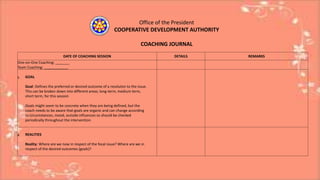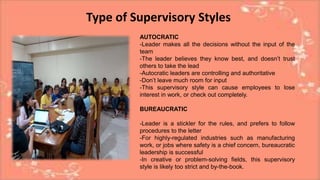Module 9 Role of Supervisor
- 1. Dimension of Supervisory Style The Role of Supervisor DPA 306: HUMAN RESOURCE MANAGEMENT AND DEVELOPMENT JOSEFINA B. BITONIO, DPA PROFESSOR PRESENTED BY: GILBERTO S. CARIÑO, MPA DPA STUDENT
- 2. The Role of Supervisor (Legaspi) The role of the supervisor is critical in enhancing employee motivation. Supervisors involves more than enhancing motivation. • It also include planning the way the work is to be accomplished; • Coordinating the efforts of the workers/subordinates; • Monitoring and controlling performance; • Interacting with both the superiors and subordinates; • Priority: motivate workers or employee to do their best work; and • Focus primarily on the “people” aspects of management. All of these elements constitute the style of supervision.
- 3. Three Dimension of Supervisory Style Tannenbum and Schmidt Model (taken from Peterson and Tracy, p3) as cited by Legaspi: Human Resource Management Action sets no limits on subordinates Autocratic Authoritarian Democratic Laissez-Faire 1. One-dimensional continuum : The Autocratic-Laissez-Faire or Authoritarian-Democratic Continuum
- 4. Three Dimension of Supervisory Style One-dimensional continuum : The Autocratic-Laissez-Faire or Authoritarian-Democratic Continuum
- 5. Three Dimension of Supervisory Style 2. Two-dimensional model The model stresses two primary independent dimensions of leader behavior. The first dimension is called “Initiating Structure” which includes such activities as assigning work, insisting on the application of work standard, requiring that the supervisor be kept informed, encouraging overtime work, criticizing poor work, and exerting pressure toward more work effort.
- 6. Three Dimension of Supervisory Style 2. Two-dimensional model The second dimension is consideration includes behavior such as helping subordinates with their personal problems, expressing appreciation for good work and avoiding criticism of poor work, considering employee’s feelings, treating, subordinates as equals, being receptive to suggestion, and consulting with subordinates about changes.
- 7. Three Dimension of Supervisory Style • This dimension emphasize the role of the supervisor as a “Facilitator” • Supervisor encourages the employee to suggest work improvements; • Asks the subordinates for their ideas when faced with a difficult problem; • Encourages subordinates to look for better ways to do the job; and • Assigns and designs tasks or jobs that are challenging 3. Third dimension-facilitating development
- 8. What Are Supervisory Styles? Levinson, 2018) A supervisory style is your approach to directing, managing, motivating and communicating with employees. There are many leadership styles, each with their strengths and weaknesses. While certain supervisory styles are commonly considered superior methods, the reality is that no leadership style is one-size-fits-all. A good leader knows when and how to use the various supervisory styles to maximize results from his or her team. Supervisory style says a lot about how you lead people, including how you communicate, how controlling you are and how much input you allow into your decision-making process
- 9. Type of Supervisory Styles -Leader focuses on one-on-one development with an employee -Relationship often looks like that of a mentor and mentee -Helps develop an individual to get the most out of their performance, priming them for bigger things -Coach must learn the worker’s strengths and weaknesses -Coaching is an excellent supervisory style to use when an employee or team member is struggling or becoming disengaged from their work. -Can work for highly motivated individuals who are looking to gain promotion COACHING
- 10. The performance of the office and every individual shall be regularly monitored at various levels. Monitoring and evaluation mechanisms ensure that timely and appropriate steps can be taken to keep a program on track, and that its objectives or goals are met in the most effective manner. Managers and supervisors act as coaches and mentors to provide an enabling environment/intervention to improve team performance, and to manage and develop individual potentials. The need for performance monitoring and coaching
- 12. Office of the President COOPERATIVE DEVELOPMENT AUTHORITY COACHING JOURNAL DATE OF COACHING SESSION DETAILS REMARKS One-on-One Coaching: _______ Team Coaching: ____________ 1. GOAL Goal: Defines the preferred or desired outcome of a resoluton to the issue. This can be broken down into different areas; long-term, medium term, short term, for this session Goals might seem to be concrete when they are being defined, but the coach needs to be aware that goals are organic and can change according to circumstances, mood, outside influences so should be checked periodically throughout the intervention. 2. REALITIES Reality: Where are we now in respect of the focal issue? Where are we in respect of the desired outcomes (goals)?
- 13. Office of the President COOPERATIVE DEVELOPMENT AUTHORITY COACHING JOURNAL 3. OPTIONS Options: What are the coachee's options in moving forward towards the goal or outcome? This is an area in which a less experienced coach can be misled by a client into accepting a handful of options, but should be pushing hard to unleash or unlock some 'wildcard' options. Engaging with the coachee's creativity to find innovative or wacky possibilities can sometimes reveal new routes to success. DETAILS REMARKS 4. WILL/ WAY FORWARD Way forward: Once coach and coachee have explored some options and discarded the impossible or impractical it's time to decide on the way forward. The coach should be willing to hold the coachee accountable for his or her actions, so an exact timeframe is important. To smooth the way, it might help if the coach can remind the client that the whole can be undertaken in many small steps, so the way forward might mean one simple task being accomplished in a set time, with further clearly defined actions to follow from there. _________________________ ____________________ ________________ Name of the Coachee Name of the Coach Date
- 14. GROW model A good structure for coaching follows the initiated by John Whitmore: Goals – The coachee tells his/her coachee what it is that he/she wants to achieve. Reality – The coachee describes the current situation and/or challenges that he/she is facing. Opportunities – The coachee determines his/her perceived solutions or remedies for the current situation. Way Forward – The coachee decides on an option that he/she shall execute to overcome the present challenge. http://www.csc.gov.ph/2014-02-21-08-16-56/2014-02-21-08-17-24/2014-02-28-06-38-04.html
- 15. Type of Supervisory Styles AFFILIATIVE -Encourages teamwork and brings workers together -Often used to boost morale or bring a disjointed team together -Style of leadership is positive, encouraging and social -It’s great to connect employees and boost engagement with one another -This style of leadership is best used in conjunction with other leadership styles PACESETTING -Sets a high bar and expects all employees to reach it -Leader is continually working to improve performance, efficiency and outcomes -This supervisory style can occasionally leave employees feeling overwhelmed and frustrated.
- 16. Type of Supervisory Styles AUTOCRATIC -Leader makes all the decisions without the input of the team -The leader believes they know best, and doesn’t trust others to take the lead -Autocratic leaders are controlling and authoritative -Don’t leave much room for input -This supervisory style can cause employees to lose interest in work, or check out completely. BUREAUCRATIC -Leader is a stickler for the rules, and prefers to follow procedures to the letter -For highly-regulated industries such as manufacturing work, or jobs where safety is a chief concern, bureaucratic leadership is successful -In creative or problem-solving fields, this supervisory style is likely too strict and by-the-book.
- 17. Type of Supervisory Styles LAISSEZ-FAIRE (DELEGATIVE) -Laissez-faire or delegative leader is the polar opposite of an autocratic leader -Leader lets their employees do what they wish with relatively little supervision or direction -Leader exercises a hands-off approach, allowing workers to handle tasks as they see fit -In some cases, this supervisory style makes sense. However, for a team that requires direction and communication, a delegative leadership style is less than ideal
- 18. Type of Supervisory Styles DEMOCRATIC/PARTICIPATORY -Leader includes team member input in all decisions, but ultimately makes the final call -Encourages the team’s creativity and engagement in projects -Because of the participatory process, teams under democratic leaders can have slower results and lower productivity -Employees turn in higher quality work under democratic leadership and enjoy a high level of job satisfaction -This leadership style is known as one of the strongest supervisory styles.
- 19. Type of Supervisory Styles TRANSFORMATIONAL -A transformational leader wants nothing more than to make a change -Motivates every team member with their strong communication skills, empathy and vision -Have a high level of social intelligence and a knack for elevating everyone around them. TRANSACTIONAL -A transactional leader prefers to establish a clear chain of command, with every person on the team having a defined role. -Treats work as a transaction -Good work is rewarded, while poor work is frowned upon.
- 20. Type of Supervisory Styles SERVANT -A servant leader is the ultimate team player -Tending to lead by example, this person motivates all those around them -These leaders work hard, show integrity and embody strong company values. -A servant leader also consults all team members on decisions -This leader is likely to take responsibility for team failures, while giving the team all of the credit for wins -Employees usually feel respect and loyalty for leaders who use this supervisory style. SITUATIONAL -Leader utilizes elements from every type of leadership when necessary -Style of leadership is adaptive and flexible -Leader chooses the supervisory style a particular situation calls for -Experts consider situational leadership to be among the strongest styles of leadership
- 23. REFERENCES • Legaspi, Perla, DPA: Human Resource Management • Civil Service Commission – UNDP – Supervisory Development Course Track II & III • www.youtube.com • www.wikipedia.com • www.timebusiness.com • www.expertprogrammanagement.com • Role of Supervisor , htps://www.managementstudyguide.com/role_of_supervisor.htm Retrieve 30 August 2019 • Levinson, Chelsea : Different Supervisory Styles of Managers , https://bizfluent.com/info-7736754-different-supervisory-styles-managers.html Retrieved 30 August 2019






















